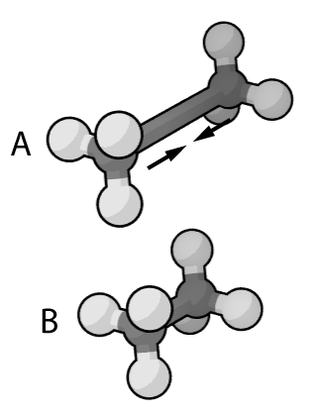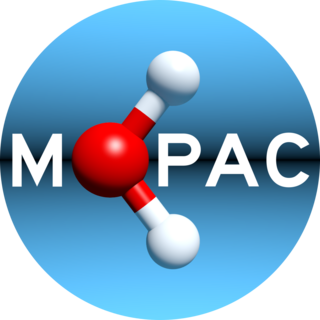
Assisted Model Building with Energy Refinement (AMBER) is the name of a widely-used molecular dynamics software package originally developed by Peter Kollman's group at the University of California, San Francisco. It has also, subsequently, come to designate a family of force fields for molecular dynamics of biomolecules that can be used both within the AMBER software suite and with many modern computational platforms.

In biology and other experimental sciences, an in silico experiment is one performed on a computer or via computer simulation software. The phrase is pseudo-Latin for 'in silicon', referring to silicon in computer chips. It was coined in 1987 as an allusion to the Latin phrases in vivo, in vitro, and in situ, which are commonly used in biology. The latter phrases refer, respectively, to experiments done in living organisms, outside living organisms, and where they are found in nature.
A chemical file format is a type of data file which is used specifically for depicting molecular data. One of the most widely used is the chemical table file format, which is similar to Structure Data Format (SDF) files. They are text files that represent multiple chemical structure records and associated data fields. The XYZ file format is a simple format that usually gives the number of atoms in the first line, a comment on the second, followed by a number of lines with atomic symbols and cartesian coordinates. The Protein Data Bank Format is commonly used for proteins but is also used for other types of molecules. There are many other types which are detailed below. Various software systems are available to convert from one format to another.

MOPAC is a computational chemistry software package that implements a variety of semi-empirical quantum chemistry methods based on the neglect of diatomic differential overlap (NDDO) approximation and fit primarily for gas-phase thermochemistry. Modern versions of MOPAC support 83 elements of the periodic table and have expanded functionality for solvated molecules, crystalline solids, and proteins.

In the field of molecular modeling, docking is a method which predicts the preferred orientation of one molecule to a second when a ligand and a target are bound to each other to form a stable complex. Knowledge of the preferred orientation in turn may be used to predict the strength of association or binding affinity between two molecules using, for example, scoring functions.

OpenEye Scientific Software is an American software company founded by Anthony Nicholls in 1997. It develops large-scale molecular modelling applications and toolkits. Following OpenEye's acquisition by Cadence Design Systems for $500 million in September 2022, the company was rebranded to OpenEye Cadence Molecular Sciences and operates as a business unit under Cadence.

The Chemistry Development Kit (CDK) is computer software, a library in the programming language Java, for chemoinformatics and bioinformatics. It is available for Windows, Linux, Unix, and macOS. It is free and open-source software distributed under the GNU Lesser General Public License (LGPL) 2.0.

Vernalis Research develops and applies fragment and structure-based methods to drug discovery, and has generated cell active lead compounds and development candidates against biological targets in oncology, neurodegeneration, anti-infectives and inflammation.
In free and open-source software (FOSS) development communities, a forge is a web-based collaborative software platform for both developing and sharing computer applications.
The PDBbind database is a comprehensive collection of experimentally measured binding affinity data for the protein-ligand complexes deposited in the Protein Data Bank (PDB). It thus provides a link between energetic and structural information of protein-ligand complexes, which is of great value to various studies on molecular recognition occurred in biological systems.
Molecular design software is notable software for molecular modeling, that provides special support for developing molecular models de novo.
This is a list of notable computer programs that are used for nucleic acids simulations.

AutoDock is a molecular modeling simulation software. It is especially effective for protein-ligand docking. AutoDock 4 is available under the GNU General Public License. AutoDock is one of the most cited docking software applications in the research community. It is used by the FightAIDS@Home and OpenPandemics - COVID-19 projects run at World Community Grid, to search for antivirals against HIV/AIDS and COVID-19. In February 2007, a search of the ISI Citation Index showed more than 1,100 publications had been cited using the primary AutoDock method papers. As of 2009, this number surpassed 1,200.
Theano is a Python library and optimizing compiler for manipulating and evaluating mathematical expressions, especially matrix-valued ones. In Theano, computations are expressed using a NumPy-esque syntax and compiled to run efficiently on either CPU or GPU architectures.

Ruth Nussinov is an Israeli-American biologist born in Rehovot who works as a professor in the Department of Human Genetics, School of Medicine at Tel Aviv University and is the senior principal scientist and principal investigator at the National Cancer Institute, National Institutes of Health. Nussinov is also the editor in chief of the Current Opinion in Structural Biology and formerly of the journal PLOS Computational Biology.
The ViennaRNA Package is software, a set of standalone programs and libraries used for predicting and analysing RNA nucleic acid secondary structures. The source code for the package is released as free and open-source software and compiled binaries are available for the operating systems Linux, macOS, and Windows. The original paper has been cited over 2,000 times.
Molecular Operating Environment (MOE) is a drug discovery software platform that integrates visualization, modeling and simulations, as well as methodology development, in one package. MOE scientific applications are used by biologists, medicinal chemists and computational chemists in pharmaceutical, biotechnology and academic research. MOE runs on Windows, Linux, Unix, and macOS. Main application areas in MOE include structure-based design, fragment-based design, ligand-based design, pharmacophore discovery, medicinal chemistry applications, biologics applications, structural biology and bioinformatics, protein and antibody modeling, molecular modeling and simulations, virtual screening, cheminformatics & QSAR. The Scientific Vector Language (SVL) is the built-in command, scripting and application development language of MOE.
FlexAID is a molecular docking software that can use small molecules and peptides as ligands and proteins and nucleic acids as docking targets. As the name suggests, FlexAID supports full ligand flexibility as well side-chain flexibility of the target. It does using a soft scoring function based on the complementarity of the two surfaces.
APBS is a free and open-source software for solving the equations of continuum electrostatics intended primarily for the large biomolecular systems. It is available under the BSD license.

Gitea is a forge software package for hosting software development version control using Git as well as other collaborative features like bug tracking, code review, continuous integration, kanban boards, tickets, and wikis. It supports self-hosting but also provides a free public first-party instance. It is a fork of Gogs and is written in Go. Gitea can be hosted on all platforms supported by Go including Linux, macOS, and Windows. The project is funded on Open Collective.










